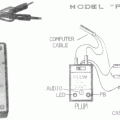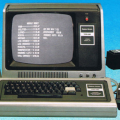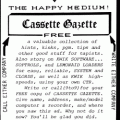Product Review – The Cassette Gazette Page 9
The Cassette Gazette was a 1983 one issue advertising newsletter that was a joint production of Lemons Tech and KWIK Software. The Gazette described the products sold by the two companies, mixed in with operational advice and interesting facts about using cassettes with your TRS-80. It appears to have been written by Wayne Lemons, the founder of Lemons Tech. The Gazette is reproduced here page by page with permission from Wayne Lemons' family.
Product Review: Cassette Enhancements – Lemons Tech Services and KWIK Software
by Richard Kaplan
When the owner of an overworked cassette system considers purchasing a mass-storage device for his computer, the possibilities are enormous. Aside from the classic diskette drive, there are companies which promote stringy floppies, hard disk drives, tape drives (such as those used with mainframe computers), and even an 8-track cartridge system to store programs. Unfortunately, each of these systems has one significant drawback: cost. Lemons Tech Services and Kwik Software each offer a unique alternatives; a “cassette loader” for $17.99 to increase cassette reliability and a “cassette operating system” for $26 which can decrease loading time by as much as a factor of six.
Lemons Tech Services manufactures hardware enhancements for cassette owners; Kwik Software develops software. Although each company actively promotes the other’s product and the software and hardware do complement each other, either product may be used independently. Thus, let’s first examine the hardware aspect of this unique cassette enhancement.
The Lemons Tech Loader
Lemons Tech offers a variety of loaders, varying in price from $17.99 to $29.99. Models are available which can run on either the Model I or Model III (although a switch may need to be activated for Model III operation at high baud).
Essentially a cassette loader is a “black box” which eliminates the guesswork in setting the volume level when loading programs from cassette. The Lemons Tech loaders are designed to operate with the cassette volume level set at the highest setting. The loader’s circuitry monitors the volume level for you.
Setting It Up
Installing the loader is quite simple. The cassette cable plug which normally is inserted in the “ear” jack should be inserted into the loader, a wire attached to the loader itself plugs into the cassette recorder’s ear jack. Once the volume level is adjusted to its highest setting, the computer operator need not know the loader is even set up. No batteries or external power is needed.
(NOTE: The loader’s instructions make a point of the fact that the loader is designed for the Radio Shack CTR80 or CTR80A. Resistors are provided for modifying the CTF41 or CCR81, a modification which requires opening these recorders and soldering new resistors. The loader may not function with other cassette recorders.)
What Does It Do?
The loader by itself does not increase program loading speed. Instead, it is designed as a stand-alone product which increases cassette reliability. Difficulties with volume settings and poor reproduction quality are greatly diminished. In addition, a jack for a speaker or earphone is provided to listen to program saves or loads without pulling plugs from the cassette recorder.
Optional Features
A number of optional features are available for a quite nominal cost. For $19.99 ($2 above the standard MODEL LC), the MODEL LCM included a built-in audio monitor for listening to program saves/loads without a speaker or earphone. Other models include a volume control and/or an audio monitor. Finally, the “top-of-the-line” MODEL LLQ-2MC has an output jack for copying tapes from one recorder to another.
Another Hardware Addition
Another standalone product available as a cassette enhancement is the SOFTROL SOFT SWITCH for $18.99. This device has two primary functions:
- An override switch enables freer tape positioning without pulling plugs from your cassette recorder
- A delayed motor-off feature automatically places gaps between your programs, allowing for easier program location and a lessened chance of data being damaged at the end of a program, when the motor is turned off.
An Analysis of Lemons Tech
Lemons Tech hardware appears to be very reliable, and it has a price which can’t be beat. The instructions provided clearly indicate the manufacturer’s competency in the area of cassette storage, noting subtle differences in the operation of the various Radio Shack cassette recorders. (Did you know the CTR80 and 80A allow you to rewind and fast-forward a tape while hooked up to a computer, while the CTR41 does not?) In short, Lemons Tech loaders are highly recommended to any cassette owner who has ever experienced loading difficulties.
The KWIK Software “Operating System”
The heart of the KWIK Software offerings appears to be the cassette operating system. Actually, there are two different operating systems – KOS3 for the Model III and KWICOS for the Model I. These operating systems can improve cassette loading time as much as 6X, and they add many disk-like commands to cassette BASIC.
Running the Program
KWICOS and KOS3 are machine-language programs which occupy 1700 bytes of memory. Program loading instructions are quite explicit, and a friendly but stern warning message warns the user that the program is solely for his personal use. The inclusion of the user’s name and address when first running the program is undoubtedly an effective deterrent to piracy.
The “KWIK” Storage Format
Certainly the most significant feature of these cassette operating systems is the KWIK storage format. Programs stored in the manner are saved at 2200 baud on the Model III (almost a 50% improvement over 1500 baud) and 2 times to 6 times faster on the Model I. Loading time saved becomes more dramatic as program length increases, as 20 seconds of “gear shifting” is requires to achieve the maximum 3000 baud. Typically, a 4-minute Model I program would load in 56 seconds under the KWIK format.
The KWIK storage procedure includes an enhanced verification process. Even if no speed were gained, KOS3 would be worth $26 for this feature alone.
“Disk Features”
A number of features are available in both KWICOS and KOS3 which simulate a disk operating system. Programs saved on cassette may be given passwords and even comments and a “directory”, including program lengths, may be obtained. In addition, graphics are used to indicate which process is occurring at any given time. Even error messages are improved, such as “RECORDER NOT READY”.
A keyboard debounce feature and a variable-speed LIST command are available, In addition, KOS3 (Model III) adds a simple command to deactivate the BREAK key, simplified I/O routing (easily route your printer output to RS-232, for example), a command to display the real-time clock, and provisions for maintaining the current date.
Conclusion
It is possible to continue reciting commands, features, and praise for both the Lemons Tech loaders and the KWIK Software cassette operating system. However, I feel that the information presented here speaks for itself. For $43.95 complete ($26 for KOS3 or KWICOS + $17.99 for a loader), this combination of hardware and software is the mass storage answer for the computerist on a budget. If you are still using a cassette system and do not plan to expand in the near future, there is no excuse not to purchase these products.












